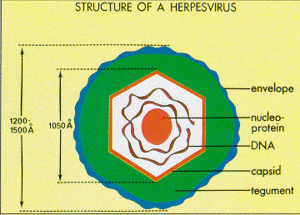Roseolovirus
Classification
Viruses; dsDNA viruses, no RNA stage; Herpesvirales; Herpesviridae; Betaherpesvirinae; Roseolovirus [Others may be used. Use NCBI link to find]
Roseolovirus 6A, 6B, 7
Description and Significance
Roseolovirus is a group 1 virus according to the Baltimore classification system. This distinction indicates double stranded viral DNA. Other viruses in Group 1 include the family Poxviridae which includes the smallpox virus, and other subfamilies within the Herpesviridae family like varicella-zoster virus that causes chickenpox. [1]
Roseoloviruses infect human hosts and can integrate into the host's genome where it enters a latent stage. Certain drugs have been shown to reactivate the virus. However, reactivations rarely occur in immunocompetent hosts. [4]
Structure, Metabolism, and Life Cycle
Interesting features of its structure; how it gains energy (how it replicates, if virus); what important molecules it produces (if any), does it have an interesting life cycle?
HHV-6A and HHV-6B both recognize CD46 receptor, an important cell membrane protein found in host cells of the complement system of the immune response. The ubiquity of this receptor indicates the vast infection potential of the virus. However, productive infection is actually limited. [2]
Studies on HHV-6A and HHV-6B have shown that the viruses target cells of the immune system, primarily CD4+ T cells. For example, T cell infection can cause the downregulation of CD3, which makes the T cell unable to activate by antigen-producing cells. The viruses successfully complete lytic cycles in lymphoid cells. B cells are not usually infected. HHV-6A and HHV-6B are also able to enter the lysogenic cycle and viral genomes have been found in dendritic cells. [2]
Pathogenesis
Roseoloviruse HHV-6B can cause roseola infantum (aka Exanthema Subitum) in children under the age of three. Symptoms include a high-grade fever and a rash originating on the trunk. [3] The severity of the fever can induce seizures. Treatment is often limited to fever-reducing medications like acetaminophen and ibuprofen as the rash and fever resolve in a few days. Sedatives may be administered to patients who are susceptible to seizures. [5]
Because herpesviruses can integrate into the host's genome, reactivations can occur in immunocompromised hosts. These symptoms include rash, fever, seizures, encephalopathy, limbic encephalitis, amnesia, cognitive dysfunction, lymphadenopathy, colitis and hepatitis. [4]
Other associations between HHV-6A and HHV-6B and several autoimmune disorders have been investigated. These studies produced results with varying degrees of evidentiary support. [2]
Although there is no evidence of HHV-6A playing a role in the pathogenesis of Multiple Sclerosis, active HHV-6A infection was found in the blood and cerebrospinal fluid of patients with relapsing MS. Other indications of HHV-6A were also discovered in MS patients. [2]
References
[1] EXAMPLE ONLY. REPLACE WITH YOUR REFERENCES. Takai, K., Sugai, A., Itoh, T., and Horikoshi, K. 2000. "Palaeococcus ferrophilus gen. nov., sp. nov., a barophilic, hyperthermophilic archaeon from a deep-sea hydrothermal vent chimney". International Journal of Systematic and Evolutionary Microbiology. 50: 489-500. http://ijs.sgmjournals.org/cgi/reprint/50/2/489
[1] Slonczewski JL, Foster JW. "Microbiology, An Evolving Science." 2nd Ed. New York: W.W. Norton and Company, Inc., 2011.
[2]
[3] Exanthem Subitum. Reference.MD. 2012. http://www.reference.md/files/D005/mD005077.html
[4] Pellett PE, Ablashi DV, Ambros PF, et al. Chromosomally integrated human herpesvirus 6: questions and answers. Rev. Med. Virol. 2012; 22: 144-155. http://onlinelibrary.wiley.com.ezp1.lib.umn.edu/doi/10.1002/rmv.715/pdf
[5] Kohl, Steve. "Human Herpesvirus 6." in Nelson Textbook of Pediatrics, edited by Richard E. Behrman. Philadelphia: W.B. Saunders Co., 1996. http://medical-dictionary.thefreedictionary.com/Roseolovirus+infections
Author
Page authored by Morgan Schwoch, student of Mandy Brosnahan, Instructor at the University of Minnesota-Twin Cities, MICB 3301/3303: Biology of Microorganisms.

